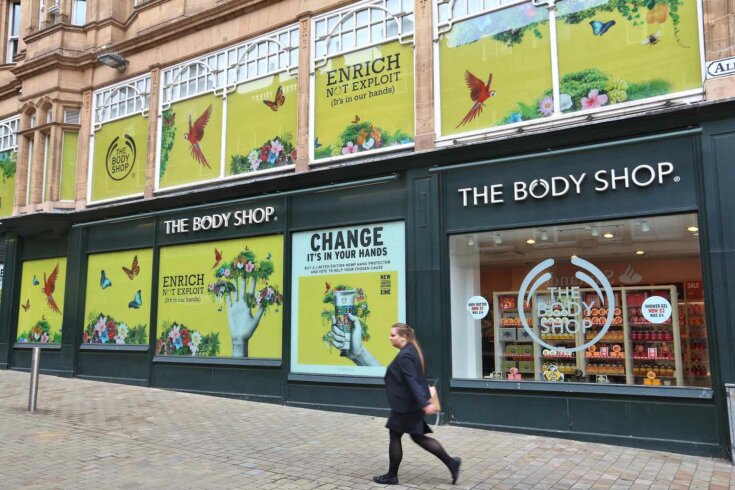When I heard the Body Shop was closing one-third of its Canadian stores, my first thought was “bananas.” Few scents can transport me back to the ’90s quite like the Body Shop Banana Shampoo does. I remember the sound the mushy mixture made when it plopped out of the bottle, ready to wash away the grunge.
As news of the company’s financial troubles spread, similarly nostalgic social media posts recalled Body Shop favourites, from Elderflower Cooling Eye Gel to Kiwi Fruit Lip Balm and Mango Body Butter. Friends declared their allegiance to White Musk or Dewberry, a nod to the store’s popular perfume oils, while other shoppers wondered how quickly they could stockpile Peppermint Invigorating Foot Cream before online sales stopped.
The Body Shop opened its first Canadian store in 1980. I discovered the retailer a few years later, when it became a mandatory stop on mall visits with my junior high friends. At holidays, the size of the Body Shop gift basket you received confirmed your status in the friend group: casual friends received a smaller basket, while besties cleaned up with a more expensive one. A single bar of Green Apple Soap was a sign you should be shopping for a new friend group.
A few weeks before the Canadian announcement, the Body Shop International Ltd. filed for administration in the UK, closing seventy-five of its almost 200 stores and doing away with approximately 300 jobs at its head office. On March 1, the Body Shop Canada Ltd. said it would halt online sales and shut down thirty-three of its 105 locations while it seeks to restructure under the Bankruptcy and Insolvency Act. The company also closed all US stores. (At its peak, the company ran 3,000 stores in more than sixty countries.)
The Body Shop was once a leader in ethical beauty: the cruelty-free, natural skin care and cosmetics the company built its brand on decades ago were the exception. But now, as demand for clean beauty—or products marketed as free of toxins and harmful chemicals—has skyrocketed, it’s hard to see where the Body Shop went wrong.
Activist Anita Roddick opened the first Body Shop in Brighton, England, in 1976 with just twenty-five products. The brand built its reputation on ethically sourced ingredients and anti-waste packaging. It was also one of the first beauty companies to campaign against animal testing. “She was a pioneer in using her company as a platform for advocating social issues, ranging from self-esteem to human rights and environmental conservation. This was not just marketing; it was a deeply held belief system that permeated every aspect of the company,” wrote consumer insights specialist Kate Hardcastle in Forbes shortly before the UK store closures were announced.
In the ’80s and ’90s, the Body Shop successfully launched social justice and environmental initiatives, including a popular collaboration with Greenpeace to end whaling (and promote jojoba oil as an alternative to sperm whale oil in cosmetics). For young people who grew up with the Body Shop, these campaigns were an introduction to activism. That’s how I discovered organizations like Amnesty International and signed petitions against animal cruelty. This was my gateway to other activist work, and had it not been for the Body Shop, I likely wouldn’t have joined Students for a Free Tibet during university or donated money to save Clayoquot Sound. Shopping at the store made me feel politically aware and more connected to various causes, often those the Body Shop introduced me to. “The shopping experience was one of living your values. No, it was better than that—you walked out smelling of your values,” wrote Zoe Williams, a columnist at the Guardian.
Roddick died in 2007, one year after the Body Shop was sold to cosmetics conglomerate L’Oréal for £652.3 million (or $2.036 billion in today’s Canadian dollars). Critics of the sale were concerned about L’Oréal’s ethics, particularly when it came to animal testing. In 2017, L’Oréal sold the company to Natura & Co., which, in late 2023, sold it to Aurelius, the Body Shop’s third owner in seven years.
Throughout this time, the Body Shop’s competition increased as clean beauty became the norm and the socially conscious, environmentally friendly buzzwords the company built its customer base on no longer had unique marketing appeal. In 2024, beauty sales are on the rise, and Sephora, Canada’s largest skin care and makeup retailer, sells products from seventy-nine clean beauty brands. Marketing around ethical consumption is now common, with both luxury and drugstore products touting sustainable, refillable, or recyclable packaging. While aging customers like me outgrew the Body Shop, it also struggled to attract millennial and Gen Z shoppers whose purchases are driven by celebrity brands and influencers.
In 2023, the Body Shop seemed to be trying to change that by returning to its activist roots. It transformed several of its Canadian stores into what it called a “changemaker’s workshop,” a concept designed to educate customers on social issues affecting their communities and inspiring them to take action. These were spaces where shoppers could sign petitions as well as explore installations supporting local artists. While the idea of one-stop shopping for social justice and Strawberry Body Mist was appealing in the company’s early years, the workshop concept seemed like a failed attempt to appeal to nostalgia from a company unable to evolve. If we want to support a cause now, we do it on social media, not in a store. “We grew up with the Body Shop, but it didn’t grow up with us,” esthetician and beauty brand developer Alicia Lartey told Refinery29.
I felt these growing pains too when, a few days after the March announcement, I found myself in a Body Shop for the first time in decades. In my mid-twenties, I abandoned my Body Shop lip balm pots in favour of cooler brands like Clinique, Calvin Klein, and MAC. Their marketing appealed to the more mature shopper in me, and their products didn’t remind me of my awkward teenage self. I still cared about the whales and Greenpeace, but my politics had become more personal, and I didn’t need an in-store poster campaign to tell me what causes to care about.
Rather than finding activism at my local mall, I found it through campus groups and university classes. It was the ’90s, and my friends and I embraced alternative culture, anti-consumerism, and Adbusters. Corporations weren’t the activists—we were. We were cynical about everything, including capitalism and a company’s ability to actually do good and make a difference. A Body Shop poster telling me to save the rainforests didn’t connect with me in the same way it had when I was younger. The messaging felt hollow and dated. I was excited about DIY movements, Riot Grrrl, and making zines—corporate messaging around social issues: not so much.
In the store, I recognized the floral smell and green walls as well as many of the items on the shelves. I felt like I had stumbled across a time capsule full of products I’d abandoned in the ’90s, along with all that patchouli and Pearl Jam. I lingered for a few minutes but felt uncomfortable. It was like connecting with an old friend you don’t have anything in common with anymore. I’d long outgrown both the brand and the idea that buying its Banana Shampoo could save the world.




